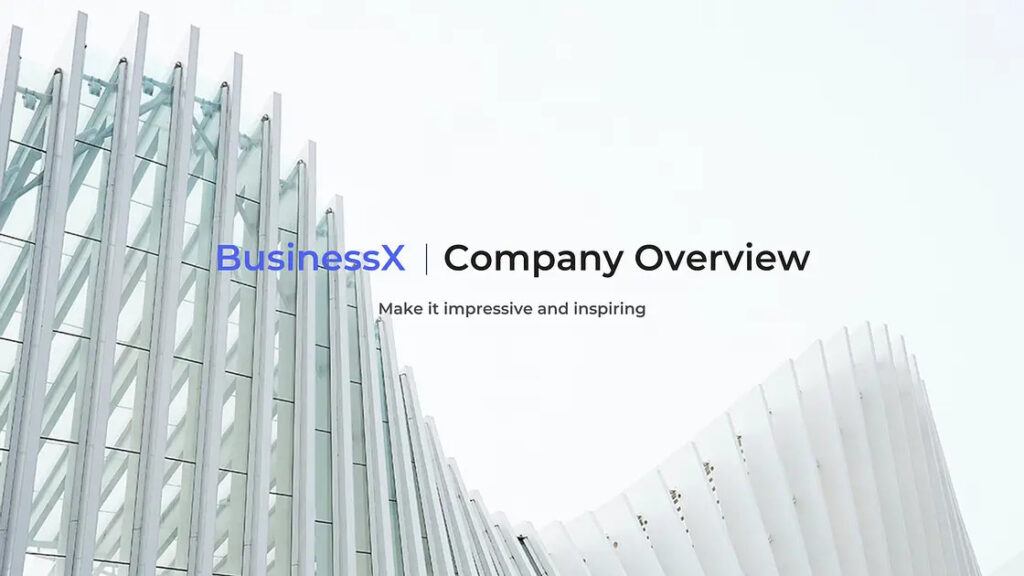In today’s fast-paced world, PowerPoint company presentation has become a popular medium for conveying information. Whether you’re presenting at a business meeting, delivering a lecture, or sharing ideas at a conference, a well-designed PowerPoint presentation can captivate your audience and leave a lasting impression. In this guide, we will explore the key elements that contribute to a successful PowerPoint presentation, providing you with valuable insights and practical examples to help you craft engaging slides that resonate with your audience.
What makes a good company presentation examples?
When it comes to creating a compelling PowerPoint presentation, it’s important to strike the right balance between captivating visuals and concise content. By employing a thoughtful approach, you can ensure that your message shines through while maintaining your audience’s attention. In this guide, we will discuss essential techniques such as clear and concise content, engaging visuals, consistent design, and effective use of white space.
Moreover, we will delve into the significance of visual hierarchy and the strategic use of animations and transitions to enhance the overall presentation experience. Additionally, we will touch upon the importance of a well-structured organization, where logical sequencing and appropriate use of headings ensure easy navigation and comprehension for your audience.
Ultimately, delivering a successful PowerPoint presentation goes beyond just the slides themselves. We will also emphasize the significance of practice and delivery techniques that complement your visuals, allowing you to confidently engage your audience and make a lasting impact.
By incorporating these tried-and-true methods and applying them to your own presentations, you can elevate your PowerPoint skills and captivate your audience with professional and visually appealing slides that leave a lasting impression.
In the following sections, we will delve deeper into each element, providing examples and practical tips to help you create exceptional PowerPoint presentations that effectively convey your message and engage your audience. Let’s get started!

How do you make the best business presentation on PowerPoint?
In the competitive world of business, effective communication is a cornerstone of success. Whether you’re pitching a new idea, presenting financial reports, or delivering a persuasive sales pitch, a well-crafted business presentation can be the key to winning over clients, investors, or colleagues. PowerPoint, with its versatility and visual appeal, remains a go-to tool for creating impactful business presentations. In this comprehensive guide, we will explore the essential steps and strategies to help you create compelling business presentations using PowerPoint.
To make a good business presentation, it is crucial to strike the right balance between engaging content and captivating visuals. By employing a systematic approach and leveraging PowerPoint’s features, you can effectively convey complex information in a visually appealing manner. In this guide, we will discuss key techniques such as concise content creation, captivating visual design, effective data visualization, and strategic use of multimedia.
Crafting a concise and compelling narrative is paramount when delivering a business presentation. We will explore techniques to distill your message into clear and concise points, ensuring that your audience can easily grasp and retain key information. Moreover, we will delve into the art of storytelling and how it can be used to create a compelling narrative that resonates with your audience, making your presentation memorable and impactful.
Create visually appealing slides
Visual design plays a critical role in holding your audience’s attention and conveying information effectively. We will discuss principles of visual design, such as consistent branding, appropriate color schemes, and effective use of typography, to create visually appealing slides that align with your business objectives and enhance the overall message delivery.
Additionally, data-driven presentations are often integral to business contexts. We will explore techniques for presenting complex data sets through meaningful visualizations, including charts, graphs, and infographics. By simplifying and organizing data, you can convey insights and trends more efficiently, ensuring your audience comprehends the information effortlessly.
In today’s digital era, multimedia elements can significantly enhance engagement and retention. We will explore the integration of multimedia, such as images, videos, and audio, to enrich your business presentations. Additionally, we will discuss the strategic use of animations and transitions to create a seamless flow between slides, maintaining your audience’s interest throughout the presentation.
Lastly, we will emphasize the importance of preparation and delivery skills to complement your PowerPoint presentation. Techniques such as practicing your speech, maintaining eye contact, and adapting to your audience’s reactions will ensure a confident and impactful delivery.
By following the strategies and best practices outlined in this guide, you can create business presentations that captivate your audience, effectively convey your message, and leave a lasting impression. Let’s dive into the following sections, where we will explore each element in detail, providing practical tips and examples to help you craft powerful business presentations using PowerPoint templates.

What should a company presentation include?
A company presentation serves as a powerful tool to showcase your organization’s mission, values, products, and achievements. Whether you’re presenting to potential investors, clients, or partners, a well-structured and engaging company presentation can make a significant impact. In this comprehensive guide, we will explore the essential components that should be included in a compelling company presentation, providing you with valuable insights and practical tips to create a presentation that captivates your audience.
Introduction and Overview
Start your presentation with a compelling introduction that grabs attention and clearly communicates your company’s purpose. Provide an overview of your organization, highlighting its history, core values, and unique selling proposition. Use this section to establish credibility and generate interest from your audience.
Mission and Vision
Clearly articulate your company’s mission and vision statements. Explain the purpose of your organization, the problems you aim to solve, and the positive impact you strive to make. Align your mission and vision with the needs and aspirations of your target audience to create a strong connection.
Products and Services
Present a detailed overview of your products and services. Highlight their features, benefits, and how they address customer needs. Use visual aids such as product images, videos, or demonstrations to enhance understanding and engagement. Emphasize any unique selling points or competitive advantages your offerings possess.
Market Analysis
Include a thorough analysis of your target market, industry trends, and competitive landscape. Demonstrate a deep understanding of your customers’ needs, preferences, and pain points. Support your analysis with data, market research, and customer testimonials to establish credibility and showcase market opportunities.
Success Stories and Achievements
Share success stories, case studies, and notable achievements to showcase your company’s track record and credibility. Highlight key milestones, partnerships, industry recognition, and satisfied customer testimonials. This helps build trust and demonstrates your ability to deliver results.
Team and Expertise
Introduce your team members, their expertise, and their roles within the organization. Highlight their qualifications, experience, and any relevant industry recognition. This section adds a personal touch and instills confidence in your audience regarding your team’s ability to execute your company’s vision.
Business Strategy and Future Outlook
Outline your company’s strategic approach and plans for growth. Present your short-term and long-term goals, along with the strategies you will employ to achieve them. Share insights on market opportunities, future product developments, and potential expansion plans. This demonstrates vision and showcases your company’s commitment to innovation and adaptability.
Call to Action
End your company presentation with a clear and compelling call to action. Prompt your audience to take the desired next step, whether it’s scheduling a meeting, making a purchase, or exploring a partnership. Provide contact information and make it easy for interested parties to connect with your company.
By incorporating these key components into your company presentation, you can create a comprehensive and impactful narrative that effectively communicates your organization’s strengths, values, and offerings. Use the following sections as a guide, where we will delve into each component in detail, providing practical tips and examples to help you craft a compelling company presentation that captivates your audience and drives business success.
